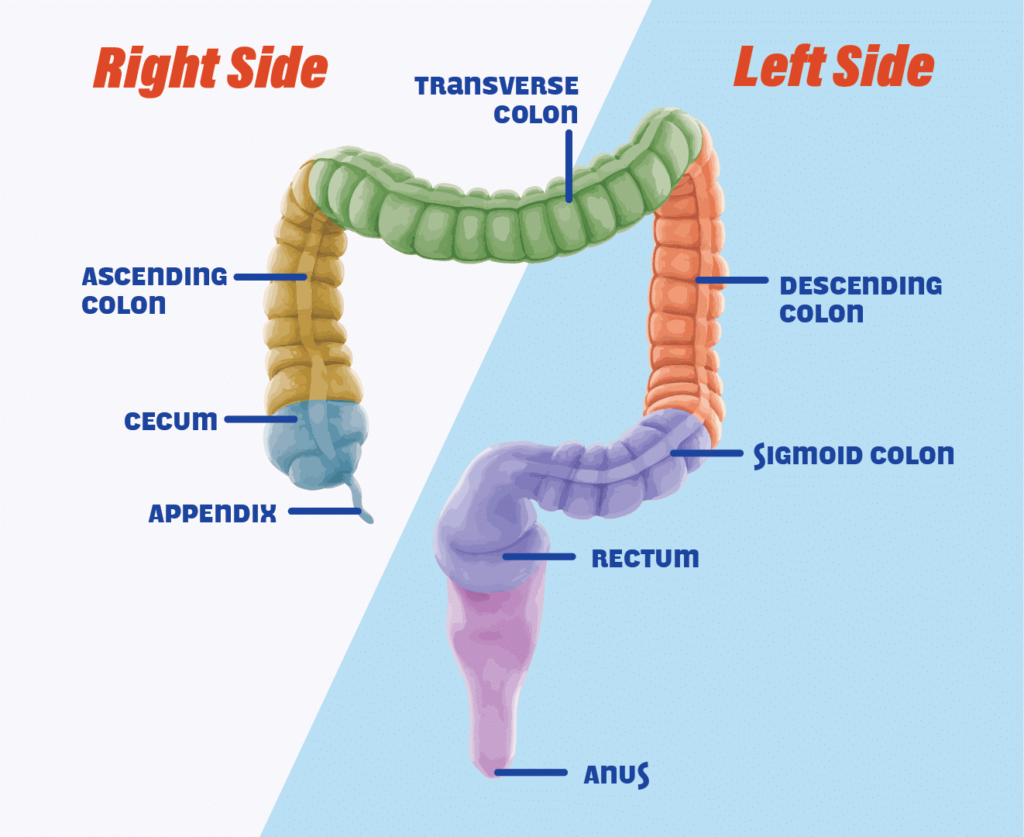The Buzz About Sidedness: What Side Is Your Cancer On?
The Buzz About Sidedness: What Side Is Your Cancer On?
Where your colorectal cancer first began matters. Not all colon cancers are the same. Knowing which side of the colon it originated can give you insight into your symptoms, impact how you heal post-surgery, and affect your treatment plan.
Your colon’s two sides
 The colon is the longest part of the large intestine that measures up to five feet long. It’s broken out into five sections, which make up the colon’s two sides: the right side and the left side.
The colon is the longest part of the large intestine that measures up to five feet long. It’s broken out into five sections, which make up the colon’s two sides: the right side and the left side.
Cecum
Located on the right side.
Connects the small intestine to the beginning of the colon.
About 7% of colon cancer cases occur here.
Ascending colon
Located on the right side.
Runs upward and connects to the transverse colon.
Absorbs water and nutrients, making stool more solid.
About 15% to 20% of colon polyps and cancers occur here.
Transverse colon
Stretches across the top of the abdomen.
Moves waste from the right side to the left side of the abdomen.
About 20% to 30% of colorectal cancers occur here.
Descending colon
Located on the left side.
Stores stool before it moves to the rectum.
About 4% to 5% of colorectal cancers occur here.
Sigmoid colon
Located on the left side.
Shaped like an “S” and connects the descending colon to the rectum.
Contracts to move waste products to the rectum and anus.
Approximately 35% to 50% of polyps and colorectal cancer develop here.
Rectum
Considered left side, although not technically part of the colon.
If you have rectal cancer, the timing of surgery and treatment plans will differ from those with a colon cancer diagnosis.
Although pathologists typically classify all colorectal cancers as adenocarcinomas (cancers that originate from glandular tissue, which lines certain internal organs and makes and releases substances in the body, such as mucus, digestive juices, and other fluids), recent discoveries have shown that not all colon cancers are the same.
When examined under a microscope, they may appear similar, but they can have different genetic abnormalities that drive their growth.
These genetic variations partially depend on where in the colon the tumor develops.
If colon cancer is on your right side
Around 15% to 20% of polyps and cancers occur on the right side of the colon, specifically the ascending colon.
Prognosis
Right-sided tumors are often more challenging to detect during a colonoscopy because they can be flat and harder to see. This means patients with right-sided colon cancer are more likely to have advanced-stage (stage III or IV) cancer. These patients also tend to be older adults.
If you have an early stage right-sided colon cancer (stage I or II), you’ll have a better prognosis. Later-stage right-sided cancers are more challenging to effectively treat.
Tumors that develop due to hereditary cancer syndromes, like Lynch syndrome, are more commonly found in the right side of the colon. (This does not include cancers due to familial adenomatous polyposis).
According to the Cleveland Clinic, up to two-thirds of colorectal cancers in African Americans are right-sided colorectal cancers; however, they are MSS tumors.
Surgery
If you have a right-sided tumor, surgery may entail removing your cecum, ascending colon and/or a portion of the transverse colon.
Before your diagnosis, you may have experienced bleeding, anemia, or unintentional weight loss. Following surgery, you may initially notice looser and more frequent stools.
It can take months for your bowel to return to its normal state. If you have concerns or are experiencing problems, ask your doctor about using Imodium® or a bulking agent like Metamucil®, or ask if there’s any other medications, diets, or tips you can try.
Treatment
Right-sided colon cancer is more commonly associated with MSI-High tumors, which have a specific genetic change affecting the cell repair process that can lead to cancer. Right-sided tumors may respond better to immunotherapy compared to left-sided tumors.
If colon cancer is on your left side
Prognosis
Left-sided colon cancer occurs more frequently than right-sided colon cancer. The prognosis is generally better for patients with left-sided colon cancer compared to right-sided colon cancer. Left-sided tumors are more easily detected during a colonoscopy and are often found earlier.
Surgery
Before a diagnosis, you may have experienced constipation, a change in bowel habits, narrow, ribbon-like stools, bleeding, and/or abdominal pain. If you need surgery for a left-sided tumor, you’ll likely have a segment of the transverse, descending, and/or sigmoid colon removed, which should remedy these symptoms.
Depending on the tumor’s location, you may also have a portion of your rectum removed. Ask your doctor for clarification that you have colon cancer and not rectal cancer. Colon cancer originates in one of the five sections of the colon, while rectal cancer originates in the rectum. Treatment plans and processes will be different for each cancer type.
If you had left-sided colon cancer removed and are experiencing frequent, small bowel movements, gas-related issues may be more prominent.
Generally, post-operative stools tend to have more form, and a significant percentage of patients eventually return to a more normal bowel pattern and consistency over time, as long as the rectum has not been affected by the surgery.
LARS
If you have a very low sigmoid tumor near the rectum, a surgical procedure known as low anterior resection (LAR) is commonly performed. A common side effect of this surgery is a condition known as low anterior resection syndrome (LARS).
With LARS, the “return to normal” after surgery may take more time, or you may experience permanent changes in your bowel function. Some patients report increased urgency, a loss of storage function, and weakened muscle sensitivity.
If you’re experiencing LARS side effects, it’s important to educate yourself and learn about what to expect and ways to effectively manage it. Additionally, this LARS Facebook group has many patients offering tips on how to manage it.
Treatment
Left-sided colon cancer tends to respond better to chemotherapy compared to right-sided colon cancer and patients have a better prognosis if diagnosed at later stages (III and IV) than right-sided colon cancer. HER2 is more common in colorectal cancer in these locations, with 10% to possibly 15% of people that have a left-sided colon cancer having this biomarker.
Patient pro tips
Staying informed about the latest advancements and evolving treatments can be challenging. Not all doctors may be fully aware of the differences between left-sided and right-sided colon tumors. Therefore, it is important for you and your caregivers to be well-informed and self-advocate.
Knowing which section and side your colon cancer began on can give you clarity about your diagnosis and understanding about how to move forward.
“My cancer appeared on the right side. I have often wondered why the right side seems to be more common in the African American community. I am not tracking it, but when I talk with other survivors and compare cancers, the right side seems like it’s more common in my community, and my medical team said the same thing.”
“Knowing my tumor was on the left side of my body brought me clarity as I finally understood the ‘why and how.’ Although I have a high pain tolerance, this proved to me I wasn’t crazy: The pain was real and so severe, at times I felt spasmodic. The final results were very important to me as I was misdiagnosed on two previous occasions.”
“My tumor was rectal, about 3.5 cm above the anal verge. So, it’s left-sided. That said, I have had polyps in the ascending colon removed which were non-cancerous. I’d say I do have right-side risk for that reason. I’ve decided to dramatically limit alcohol consumption as a result, because that’s about my only risk factor. I’m negative for Lynch. I’m only having one bottle of wine per month now. One thing I’d mention about right vs. left side is that anecdotally, I’ve heard that right-side tumors have fewer obvious symptoms such as visible bleeding, so they can be more dangerous by being found later once cancer has spread. Screening is extremely important for avoiding right-side tumors, and young people especially need to be getting fecal testing done, check blood iron levels for anemia, and consider an early colonoscopy.”
Medical Input and Review
Ryan Fields, MD, surgeon, Siteman Cancer Center
James D. Waller, MD, colon and rectal cancer surgeon (retired)
Richard M. Goldberg, MD, professor emeritus, West Virginia University Cancer Institute
Where your colorectal cancer first began matters. Not all colon cancers are the same. Knowing which side of the colon it originated can give you insight into your symptoms, impact how you heal post-surgery, and affect your treatment plan.
Your colon’s two sides
 The colon is the longest part of the large intestine that measures up to five feet long. It’s broken out into five sections, which make up the colon’s two sides: the right side and the left side.
The colon is the longest part of the large intestine that measures up to five feet long. It’s broken out into five sections, which make up the colon’s two sides: the right side and the left side.
Cecum
Located on the right side.
Connects the small intestine to the beginning of the colon.
About 7% of colon cancer cases occur here.
Ascending colon
Located on the right side.
Runs upward and connects to the transverse colon.
Absorbs water and nutrients, making stool more solid.
About 15% to 20% of colon polyps and cancers occur here.
Transverse colon
Stretches across the top of the abdomen.
Moves waste from the right side to the left side of the abdomen.
About 20% to 30% of colorectal cancers occur here.
Descending colon
Located on the left side.
Stores stool before it moves to the rectum.
About 4% to 5% of colorectal cancers occur here.
Sigmoid colon
Located on the left side.
Shaped like an “S” and connects the descending colon to the rectum.
Contracts to move waste products to the rectum and anus.
Approximately 35% to 50% of polyps and colorectal cancer develop here.
Rectum
Considered left side, although not technically part of the colon.
If you have rectal cancer, the timing of surgery and treatment plans will differ from those with a colon cancer diagnosis.
Although pathologists typically classify all colorectal cancers as adenocarcinomas (cancers that originate from glandular tissue, which lines certain internal organs and makes and releases substances in the body, such as mucus, digestive juices, and other fluids), recent discoveries have shown that not all colon cancers are the same.
When examined under a microscope, they may appear similar, but they can have different genetic abnormalities that drive their growth.
These genetic variations partially depend on where in the colon the tumor develops.
If colon cancer is on your right side
Around 15% to 20% of polyps and cancers occur on the right side of the colon, specifically the ascending colon.
Prognosis
Right-sided tumors are often more challenging to detect during a colonoscopy because they can be flat and harder to see. This means patients with right-sided colon cancer are more likely to have advanced-stage (stage III or IV) cancer. These patients also tend to be older adults.
If you have an early stage right-sided colon cancer (stage I or II), you’ll have a better prognosis. Later-stage right-sided cancers are more challenging to effectively treat.
Tumors that develop due to hereditary cancer syndromes, like Lynch syndrome, are more commonly found in the right side of the colon. (This does not include cancers due to familial adenomatous polyposis).
According to the Cleveland Clinic, up to two-thirds of colorectal cancers in African Americans are right-sided colorectal cancers; however, they are MSS tumors.
Surgery
If you have a right-sided tumor, surgery may entail removing your cecum, ascending colon and/or a portion of the transverse colon.
Before your diagnosis, you may have experienced bleeding, anemia, or unintentional weight loss. Following surgery, you may initially notice looser and more frequent stools.
It can take months for your bowel to return to its normal state. If you have concerns or are experiencing problems, ask your doctor about using Imodium® or a bulking agent like Metamucil®, or ask if there’s any other medications, diets, or tips you can try.
Treatment
Right-sided colon cancer is more commonly associated with MSI-High tumors, which have a specific genetic change affecting the cell repair process that can lead to cancer. Right-sided tumors may respond better to immunotherapy compared to left-sided tumors.
If colon cancer is on your left side
Prognosis
Left-sided colon cancer occurs more frequently than right-sided colon cancer. The prognosis is generally better for patients with left-sided colon cancer compared to right-sided colon cancer. Left-sided tumors are more easily detected during a colonoscopy and are often found earlier.
Surgery
Before a diagnosis, you may have experienced constipation, a change in bowel habits, narrow, ribbon-like stools, bleeding, and/or abdominal pain. If you need surgery for a left-sided tumor, you’ll likely have a segment of the transverse, descending, and/or sigmoid colon removed, which should remedy these symptoms.
Depending on the tumor’s location, you may also have a portion of your rectum removed. Ask your doctor for clarification that you have colon cancer and not rectal cancer. Colon cancer originates in one of the five sections of the colon, while rectal cancer originates in the rectum. Treatment plans and processes will be different for each cancer type.
If you had left-sided colon cancer removed and are experiencing frequent, small bowel movements, gas-related issues may be more prominent.
Generally, post-operative stools tend to have more form, and a significant percentage of patients eventually return to a more normal bowel pattern and consistency over time, as long as the rectum has not been affected by the surgery.
LARS
If you have a very low sigmoid tumor near the rectum, a surgical procedure known as low anterior resection (LAR) is commonly performed. A common side effect of this surgery is a condition known as low anterior resection syndrome (LARS).
With LARS, the “return to normal” after surgery may take more time, or you may experience permanent changes in your bowel function. Some patients report increased urgency, a loss of storage function, and weakened muscle sensitivity.
If you’re experiencing LARS side effects, it’s important to educate yourself and learn about what to expect and ways to effectively manage it. Additionally, this LARS Facebook group has many patients offering tips on how to manage it.
Treatment
Left-sided colon cancer tends to respond better to chemotherapy compared to right-sided colon cancer and patients have a better prognosis if diagnosed at later stages (III and IV) than right-sided colon cancer. HER2 is more common in colorectal cancer in these locations, with 10% to possibly 15% of people that have a left-sided colon cancer having this biomarker.
Patient pro tips
Staying informed about the latest advancements and evolving treatments can be challenging. Not all doctors may be fully aware of the differences between left-sided and right-sided colon tumors. Therefore, it is important for you and your caregivers to be well-informed and self-advocate.
Knowing which section and side your colon cancer began on can give you clarity about your diagnosis and understanding about how to move forward.
“My cancer appeared on the right side. I have often wondered why the right side seems to be more common in the African American community. I am not tracking it, but when I talk with other survivors and compare cancers, the right side seems like it’s more common in my community, and my medical team said the same thing.”
“Knowing my tumor was on the left side of my body brought me clarity as I finally understood the ‘why and how.’ Although I have a high pain tolerance, this proved to me I wasn’t crazy: The pain was real and so severe, at times I felt spasmodic. The final results were very important to me as I was misdiagnosed on two previous occasions.”
“My tumor was rectal, about 3.5 cm above the anal verge. So, it’s left-sided. That said, I have had polyps in the ascending colon removed which were non-cancerous. I’d say I do have right-side risk for that reason. I’ve decided to dramatically limit alcohol consumption as a result, because that’s about my only risk factor. I’m negative for Lynch. I’m only having one bottle of wine per month now. One thing I’d mention about right vs. left side is that anecdotally, I’ve heard that right-side tumors have fewer obvious symptoms such as visible bleeding, so they can be more dangerous by being found later once cancer has spread. Screening is extremely important for avoiding right-side tumors, and young people especially need to be getting fecal testing done, check blood iron levels for anemia, and consider an early colonoscopy.”
Medical Input and Review
Ryan Fields, MD, surgeon, Siteman Cancer Center
James D. Waller, MD, colon and rectal cancer surgeon (retired)
Richard M. Goldberg, MD, professor emeritus, West Virginia University Cancer Institute
Where your colorectal cancer first began matters. Not all colon cancers are the same. Knowing which side of the colon it originated can give you insight into your symptoms, impact how you heal post-surgery, and affect your treatment plan.
Your colon’s two sides
 The colon is the longest part of the large intestine that measures up to five feet long. It’s broken out into five sections, which make up the colon’s two sides: the right side and the left side.
The colon is the longest part of the large intestine that measures up to five feet long. It’s broken out into five sections, which make up the colon’s two sides: the right side and the left side.
Cecum
Located on the right side.
Connects the small intestine to the beginning of the colon.
About 7% of colon cancer cases occur here.
Ascending colon
Located on the right side.
Runs upward and connects to the transverse colon.
Absorbs water and nutrients, making stool more solid.
About 15% to 20% of colon polyps and cancers occur here.
Transverse colon
Stretches across the top of the abdomen.
Moves waste from the right side to the left side of the abdomen.
About 20% to 30% of colorectal cancers occur here.
Descending colon
Located on the left side.
Stores stool before it moves to the rectum.
About 4% to 5% of colorectal cancers occur here.
Sigmoid colon
Located on the left side.
Shaped like an “S” and connects the descending colon to the rectum.
Contracts to move waste products to the rectum and anus.
Approximately 35% to 50% of polyps and colorectal cancer develop here.
Rectum
Considered left side, although not technically part of the colon.
If you have rectal cancer, the timing of surgery and treatment plans will differ from those with a colon cancer diagnosis.
Although pathologists typically classify all colorectal cancers as adenocarcinomas (cancers that originate from glandular tissue, which lines certain internal organs and makes and releases substances in the body, such as mucus, digestive juices, and other fluids), recent discoveries have shown that not all colon cancers are the same.
When examined under a microscope, they may appear similar, but they can have different genetic abnormalities that drive their growth.
These genetic variations partially depend on where in the colon the tumor develops.
If colon cancer is on your right side
Around 15% to 20% of polyps and cancers occur on the right side of the colon, specifically the ascending colon.
Prognosis
Right-sided tumors are often more challenging to detect during a colonoscopy because they can be flat and harder to see. This means patients with right-sided colon cancer are more likely to have advanced-stage (stage III or IV) cancer. These patients also tend to be older adults.
If you have an early stage right-sided colon cancer (stage I or II), you’ll have a better prognosis. Later-stage right-sided cancers are more challenging to effectively treat.
Tumors that develop due to hereditary cancer syndromes, like Lynch syndrome, are more commonly found in the right side of the colon. (This does not include cancers due to familial adenomatous polyposis).
According to the Cleveland Clinic, up to two-thirds of colorectal cancers in African Americans are right-sided colorectal cancers; however, they are MSS tumors.
Surgery
If you have a right-sided tumor, surgery may entail removing your cecum, ascending colon and/or a portion of the transverse colon.
Before your diagnosis, you may have experienced bleeding, anemia, or unintentional weight loss. Following surgery, you may initially notice looser and more frequent stools.
It can take months for your bowel to return to its normal state. If you have concerns or are experiencing problems, ask your doctor about using Imodium® or a bulking agent like Metamucil®, or ask if there’s any other medications, diets, or tips you can try.
Treatment
Right-sided colon cancer is more commonly associated with MSI-High tumors, which have a specific genetic change affecting the cell repair process that can lead to cancer. Right-sided tumors may respond better to immunotherapy compared to left-sided tumors.
If colon cancer is on your left side
Prognosis
Left-sided colon cancer occurs more frequently than right-sided colon cancer. The prognosis is generally better for patients with left-sided colon cancer compared to right-sided colon cancer. Left-sided tumors are more easily detected during a colonoscopy and are often found earlier.
Surgery
Before a diagnosis, you may have experienced constipation, a change in bowel habits, narrow, ribbon-like stools, bleeding, and/or abdominal pain. If you need surgery for a left-sided tumor, you’ll likely have a segment of the transverse, descending, and/or sigmoid colon removed, which should remedy these symptoms.
Depending on the tumor’s location, you may also have a portion of your rectum removed. Ask your doctor for clarification that you have colon cancer and not rectal cancer. Colon cancer originates in one of the five sections of the colon, while rectal cancer originates in the rectum. Treatment plans and processes will be different for each cancer type.
If you had left-sided colon cancer removed and are experiencing frequent, small bowel movements, gas-related issues may be more prominent.
Generally, post-operative stools tend to have more form, and a significant percentage of patients eventually return to a more normal bowel pattern and consistency over time, as long as the rectum has not been affected by the surgery.
LARS
If you have a very low sigmoid tumor near the rectum, a surgical procedure known as low anterior resection (LAR) is commonly performed. A common side effect of this surgery is a condition known as low anterior resection syndrome (LARS).
With LARS, the “return to normal” after surgery may take more time, or you may experience permanent changes in your bowel function. Some patients report increased urgency, a loss of storage function, and weakened muscle sensitivity.
If you’re experiencing LARS side effects, it’s important to educate yourself and learn about what to expect and ways to effectively manage it. Additionally, this LARS Facebook group has many patients offering tips on how to manage it.
Treatment
Left-sided colon cancer tends to respond better to chemotherapy compared to right-sided colon cancer and patients have a better prognosis if diagnosed at later stages (III and IV) than right-sided colon cancer. HER2 is more common in colorectal cancer in these locations, with 10% to possibly 15% of people that have a left-sided colon cancer having this biomarker.
Patient pro tips
Staying informed about the latest advancements and evolving treatments can be challenging. Not all doctors may be fully aware of the differences between left-sided and right-sided colon tumors. Therefore, it is important for you and your caregivers to be well-informed and self-advocate.
Knowing which section and side your colon cancer began on can give you clarity about your diagnosis and understanding about how to move forward.
“My cancer appeared on the right side. I have often wondered why the right side seems to be more common in the African American community. I am not tracking it, but when I talk with other survivors and compare cancers, the right side seems like it’s more common in my community, and my medical team said the same thing.”
“Knowing my tumor was on the left side of my body brought me clarity as I finally understood the ‘why and how.’ Although I have a high pain tolerance, this proved to me I wasn’t crazy: The pain was real and so severe, at times I felt spasmodic. The final results were very important to me as I was misdiagnosed on two previous occasions.”
“My tumor was rectal, about 3.5 cm above the anal verge. So, it’s left-sided. That said, I have had polyps in the ascending colon removed which were non-cancerous. I’d say I do have right-side risk for that reason. I’ve decided to dramatically limit alcohol consumption as a result, because that’s about my only risk factor. I’m negative for Lynch. I’m only having one bottle of wine per month now. One thing I’d mention about right vs. left side is that anecdotally, I’ve heard that right-side tumors have fewer obvious symptoms such as visible bleeding, so they can be more dangerous by being found later once cancer has spread. Screening is extremely important for avoiding right-side tumors, and young people especially need to be getting fecal testing done, check blood iron levels for anemia, and consider an early colonoscopy.”
Medical Input and Review
Ryan Fields, MD, surgeon, Siteman Cancer Center
James D. Waller, MD, colon and rectal cancer surgeon (retired)
Richard M. Goldberg, MD, professor emeritus, West Virginia University Cancer Institute






